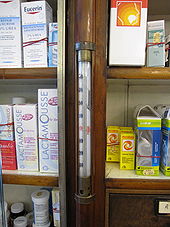- Réaumur scale
-
The Réaumur scale (°Ré, °Re, °R), also known as the "octogesimal division",[1] is a temperature scale in which the freezing and boiling points of water are set to 0 and 80 degrees respectively. The scale is named after René Antoine Ferchault de Réaumur, who first proposed something similar in 1730.[2]
Réaumur’s thermometer contained diluted alcohol and was constructed on the principle of taking the freezing point of water as 0°, and graduating the tube into degrees each of which was one-thousandth of the volume contained by the bulb and tube up to the zero mark. He suggested that the quality of alcohol employed be such that it began boiling at 80 °Ré — that is, when it had expanded in volume by 8 %. He chose alcohol instead of mercury on the grounds that it expanded more visibly, but this posed problems: his original thermometers were very bulky, and the low boiling point of alcohol made them unsuitable for many applications. Instrument-makers generally chose different liquids, and then used 80 °Ré to signify the boiling point of water, causing much confusion. In 1772 Jean-André Deluc studied the several substances then used in thermometers in the light of new theories of heat and came to the conclusion that mercurial thermometers were the best for practical use; for example, if two equal amounts of water at x and y degrees were mixed, the temperature of the result was then the average of x and y degrees, and this relationship only held reliably when mercury was used. From the late 18th century mercury was used almost without exception. These thermometers, the stems of which are graduated into eighty equal parts between the freezing and boiling points of water, are not Réaumur's original thermometers in anything but name.[3]
Use
 Charles Minard's information graphic of the 1812 French invasion of Russia. The horizontal graph on the bottom, designed to be read from right to left, depicts the temperature on the army's return from Russia, in degrees below freezing on the Réaumur scale.
Charles Minard's information graphic of the 1812 French invasion of Russia. The horizontal graph on the bottom, designed to be read from right to left, depicts the temperature on the army's return from Russia, in degrees below freezing on the Réaumur scale.
The Réaumur scale saw widespread use in Europe, particularly in France and Germany as well as Russia, as referenced in works of Dostoyevsky, Tolstoy, and Nabokov.[4][5][6] By the 1790s, France chose the Celsius scale for the metric system over the Réaumur measurements.[2] Its only modern use is in the measuring of milk temperature in cheese production. It is used in some Italian dairies making Parmigiano-Reggiano and Grana Padano cheeses and in Swiss Alp cheeses.[7]
Réaumur temperature conversion formulae from Réaumur to Réaumur Celsius [°C] = [°Ré] × 5⁄4 [°Ré] = [°C] × 4⁄5 Fahrenheit [°F] = [°Ré] × 9⁄4 + 32 [°Ré] = ([°F] − 32) × 4⁄9 Kelvin [K] = [°Ré] × 5⁄4 + 273.15 [°Ré] = ([K] − 273.15) × 4⁄5 Rankine [°R] = [°Ré] × 9⁄4 + 491.67 [°Ré] = ([°R] − 491.67) × 4⁄9 For temperature intervals rather than specific temperatures,
1 °Ré = 1.25 °C = 2.25 °F
Comparisons among various temperature scalesConversion table between the different temperature units








References
- ^ Division octogesimale in French.
- ^ a b Simons, Paul (17 October 2007). "How Reaumur fell off the temperature scale". The Times. http://www.timesonline.co.uk/tol/news/weather/article2673568.ece. Retrieved 2008-03-10.
- ^ Herbert Dingle. The scientific adventure: essays in the history and philosophy of science. Sir Isaac Pitman and Sons, London, 1952. Page 131.
- ^ Fyodor Dostoyevsky, Crime and Punishment, p. 268 Vintage Books
- ^ Leo Tolstoy, Anna Karenina, p. 685, Wordsworth Editions Limited
- ^ Vladimir Nabokov, The Real Life of Sebastian Knight, p. 1. Penguin Books.
- ^ Reaumur thermometer for Parmigiano-Reggiano cheese)
Scales of temperature Categories:- Obsolete units of measure
- Units of temperature
- Science and technology in France
Wikimedia Foundation. 2010.

